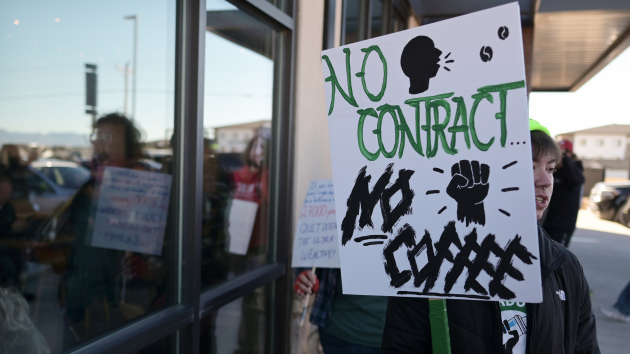Rising temperatures could impact quality of grapes used to make wine in Napa Valley, researchers say
Written by ABC Audio. All rights reserved. on August 3, 2023
(NAPA VALLEY, Calif.) — Rising temperatures are shifting the growing season in Napa Valley’s wine country, which could impact grape growth and alter the types of wine that originate from the region, according to new research and wine experts.
The wine grape-growing season in California’s Napa Valley, which has historically relied on a consistent Mediterranean-like climate, is now occurring nearly a month earlier than it did in the 1950s because of warming temperatures in the region, scientists at the University of California San Diego’s Scripps Institution of Oceanography found after analyzing local temperature records spanning between 1958 to 2016.
When the study period began, average daily temperatures typically first exceeded 50 degrees Fahrenheit consistently around April 1, according to the study, published in International Journal of Climatology. By 2016, the growing season generally began around March 1, the researchers found.
Temperature is “vital” for grape growth and grape characteristics, Scripps Institution of Oceanography research meteorologist Daniel Cayan and author of the study, told ABC News. Temperature characteristics have “well-known” impacts on grape growth and grape quality.
Any changes to the grapes could also affect the quality of the region’s signature wine, Napa Valley vintners told ABC News.
“If you want to be in the wine business, you want to be growing grapes. With quality wine, you want to match your varieties to your particular environment, your heat environment,” John Caldwell, an owner of the Caldwell Vineyard in the Napa Valley, told ABC News.
Napa Valley has warmed between 1 and 2 degrees Fahrenheit since the 1930s, according to a 2011 report by the Napa Valley Vintners trade association. The region’s climate is unique because it is affected by both cooler maritime influences and inland heat, the researchers said.
The strongest changes took hold in the 1970s and warmed “pretty dramatically” through the 1990s, which lines up with the large-scale North Pacific climate shift that commenced in the mid-1970s, Cayan said.
“Wine grapes offer a super interesting lens through which we can view climate variation,” Cayan said.
The average temperature of the last 45 days of the growing season also warmed by more than 3 degrees Fahrenheit during the study period, according to the paper.
The continued anomalous warmth of the last seven years combined with projected further warming strongly suggests that an additional 1 degree Fahrenheit of warming is likely within the next three decades, along with more significant and more frequent bouts of extreme heat, the researchers said.
The changes in Napa Valley reflect warming trends seen elsewhere in the western U.S. where temperatures overall have risen about 2 degrees Fahrenheit since the 1950s as well, the researchers said. Napa has shown a significant reduction in the occurrence of cool extremes and an increased occurrence of warm extremes.
“There’s been widespread warming in western North American climate,” Cayan said. “That is quite well known to the both of the climate community and to stakeholders in the region.”
The study also looked at the time required to bring wine grapes to maturity, including measuring the occurrence of extreme hot days that may be detrimental to grape quality and the temperature during the final 45 days before grapes mature — a period that is vital in determining grapes’ sugar content and flavor.
The grapes will also mature about a month earlier than they did in the 1950s, but the actual harvest date is more changeable, as some vintners may make stylistic choices to delay harvest, according to the study.
“This is a remarkable long-term shift given that wine grapes require about six months to mature on the vine and most year-to-year fluctuations in the growing season start were typically limited to about three weeks,” Cayan said in a statement following the publishing of the study.
The paper aimed to chart the effects the growing influence of human-caused climate change, as well as effects from natural climate variations, such as the Pacific Decadal Oscillation, on the seasonal rhythms and shorter term temperature extremes in Napa Valley. The research was funded by Napa Valley Vintners and supported by the National Oceanic and Atmospheric Administration and the U.S. Geological Survey.
It is important for the Napa vintners to have a strong understanding of how weather and climate are varying, Cayan said. Going forward, vintners will need to carefully monitor the climate, especially during certain times of year, like the harvest, when temperatures are vital, Cayan said.
“Our livelihood is very much impacted by the climate,” Hugh Davies, president of Schramsberg Vineyards and Davies Vineyards in the Napa Valley, told ABC News.
Climate changes are likely to drive Napa growers to continue to innovate by introducing novel growing practice and grape varieties that might be more heat-tolerant, Cayan said.
If the environment gets warmer, growers will have to choose new varieties, Caldwell said.
“You change your whole viticulture, is what you do, just to match your weather,” Caldwell said.
Napa hasn’t seen enough of an extreme increase in heat to necessitate a change in grape varieties yet, but it is a topic that Caldwell and other growers in the region are already immersing themselves in, he said.
Other historical wine growing regions, such as France or Italy, already share similar concerns regarding the continued viability of their grape varieties and systems of agriculture due to a warming climate. Vineyards are beginning to pop up in Southern England due to the warming climate, a notion that would have been “unheard of” three or four decades ago, Caldwell said.
“We are in a global warming period,” Caldwell said. “It will certainly change varieties all over the world.”
But every year is different, Davies said.
The harvest this year is at least three weeks late, Jamey Whetstone, owner of the Whetstone Wine Cellars in Napa, told ABC News over email.
“This is shaping up to be one of the latest harvests,” Davies said. This year’s cabernets, which rely on very ripe grapes, may suffer as a result, he added.
Copyright © 2023, ABC Audio. All rights reserved.





